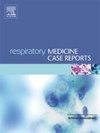elexaftor - tezaftor -ivacaftor治疗2例纯合子I1234V突变囊性纤维化的临床疗效:前瞻性病例系列
IF 0.7
Q4 RESPIRATORY SYSTEM
引用次数: 0
摘要
错义CFTR变体I1234V (c.3700A >;G)产生II类蛋白折叠缺陷,在中东地区很普遍,但纯合携带者中eleexacaftor /tezacaftor/ivacaftor (ETI)的临床证据很少。我们前瞻性地评估了ETI治疗2例纯合子I1234V囊性纤维化(CF)患儿的疗效和安全性。方法在法赫德国王医疗城进行单中心前瞻性病例系列研究。基线评估包括肺活量测定、体重指数(BMI)、痰微生物学、肝脏生化和高分辨率胸部CT。ETI根据体重给药开始,并在6个月和8个月时对患者进行回顾。主要结局是预测的1秒用力呼气量百分比(ppFEV1)和BMI的变化;次要结局是铜绿假单胞菌状态、放射学改变和不良事件。结果经ETI治疗8个月后,11岁女孩的ppFEV1从36%增加到46%,9岁男孩的ppFEV1从57%增加到73%。相应的BMI从11.71 kg/m2 (z = - 4.37)上升到15.48 kg/m2 (z = - 1.22),从12.69 kg/m2 (z = - 3.12)上升到15.74 kg/m2 (z = - 0.55)。慢性铜绿假单胞菌在两例患者中均被根除。胸部CT显示粘液堵塞减少,支气管周围壁增厚,囊性支气管扩张部分消退。结论seti对两例罕见I1234V纯合突变患儿的肺功能、营养状况、微生物清除率和影像学表现均有临床意义的改善。这些现实世界的研究结果支持将ETI扩展到罕见的II类CFTR变异患者,并证明更大规模的多中心研究可以证实疗效和长期安全性。本文章由计算机程序翻译,如有差异,请以英文原文为准。
Clinical efficacy of elexacaftor-tezacaftor-ivacaftor in two siblings with homozygous I1234V mutation cystic fibrosis: A prospective case series
Background
The missense CFTR variant I1234V (c.3700A > G) produces class II protein-folding defects and is prevalent in the Middle East, yet clinical evidence for elexacaftor/tezacaftor/ivacaftor (ETI) in homozygous carriers is sparse. We prospectively evaluated ETI efficacy and safety in two paediatric siblings with homozygous I1234V cystic fibrosis (CF).
Methods
A single-centre, prospective case series was undertaken at King Fahad Medical City. Baseline assessments included spirometry, body-mass index (BMI), sputum microbiology, liver biochemistry and high-resolution chest CT. ETI was initiated according to weight-based dosing and patients were reviewed at 6 and 8 months. Primary outcomes were change in percent-predicted forced expiratory volume in 1 second (ppFEV1) and BMI; secondary outcomes were Pseudomonas aeruginosa status, radiological changes and adverse events.
Results
After eight months of ETI, ppFEV1 increased from 36 % to 46 % in the 11-year-old girl and from 57 % to 73 % in the 9-year-old boy. Corresponding BMI rose from 11.71 kg/m2 (z = −4.37) to 15.48 kg/m2 (z = −1.22) and from 12.69 kg/m2 (z = −3.12) to 15.74 kg/m2 (z = −0.55), respectively. Chronic P. aeruginosa was eradicated in both patients. Chest CT demonstrated reduced mucus plugging and peribronchial wall thickening with partial regression of cystic bronchiectasis.
Conclusions
ETI produced clinically meaningful improvements in lung function, nutritional status, microbiological clearance and radiological appearance in two children homozygous for the rare I1234V mutation. These real-world findings support extending ETI access to patients with rare class II CFTR variants and justify larger multicentre studies to confirm efficacy and long-term safety.
求助全文
通过发布文献求助,成功后即可免费获取论文全文。
去求助
来源期刊

Respiratory Medicine Case Reports
RESPIRATORY SYSTEM-
CiteScore
2.10
自引率
0.00%
发文量
213
审稿时长
87 days
 求助内容:
求助内容: 应助结果提醒方式:
应助结果提醒方式:


